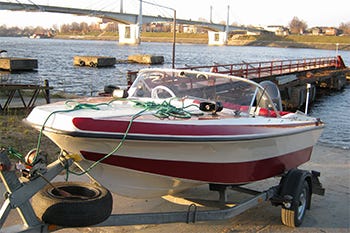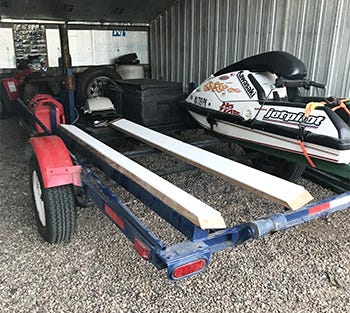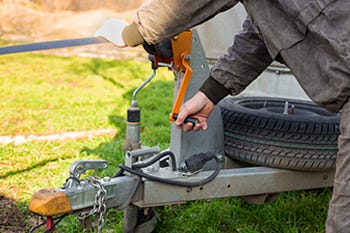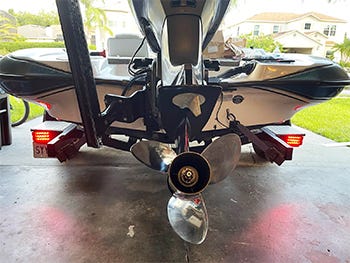

We’ve all seen it. You’re driving along a busy highway or a lonely road, and there on the shoulder is somebody’s broken down boat trailer. Sometimes it’s just a simple flat tire, and sometimes it’s something far worse — a broken axle, a missing wheel, or even a broken frame. Invariably, the trailer is broken down in the worst possible place — in the narrow emergency lane of a busy overpass or on the sloping shoulder of a deserted road. It’s a nightmare scenario for any boat owner, but the good news is that in most cases it is completely avoidable.
Contents
- 1. Boat Trailer Maintenance Basics
- 2. Boat Trailer Tire Essentials
- 2.1 Tire Inflation
- 2.2 Tire Age
- 2.3 Tire Type
- 2.4 Spare Tire
- 3. Bearings
- 4. Springs
- 5. Axles and Spindles
- 6. Frames
- 7. Bunks
- 8. Brackets and Bolts
- 9. Winch, Chains, Coupler, and Jack
- 10. Straps
- 11. Wiring and Lights
- 12. Jack and Lug Wrench
Boat Trailer Maintenance Basics
Trailers are the unsung heroes of nearly every boater. They thanklessly haul a vessel that gets all the glory and all the excitement, and they rarely get even the most basic level of attention they are due. In fairness to their owners, it’s hard to get excited about maintaining a boat trailer. Washing and waxing a boat delivers at least some satisfaction. Nobody notices well-greased bearings or new trailer springs.
When it comes to boat trailer repairs, one thing is certain — eventually, you are going to have to do them. The question for the owner is simply when — and where — those repairs will get done. While trailer maintenance may not be much fun, it’s a lot more enjoyable to do at home in your driveway than on the side of a busy road.
So, whether you are planning a long trip to an exciting destination or just considering a weekend adventure to the closest boat ramp, take a moment to give your trailer a thorough inspection, then make it at least an annual routine. Here are some key things to consider to ensure your trailering goes smoothly:
Boat Trailer Tire Essentials
Boat trailer tires play a crucial role in transporting your vessel to and from the water, making them a critical component of your boating experience. Let's explore the key considerations and practices to keep in mind to ensure your boat trailer tires are up to the task and ready to roll when it matters most.
Tire Inflation
Tire inflation on a trailer is critical. Improperly inflated tires can cause blowouts and dramatically change the way your boat rides behind your vehicle. Keeping your tires inflated to the recommended level will ensure your trailer tracks behind your tow vehicle and handles turns properly.
Tire Age
If your trailer tires are over three years old, they should be inspected thoroughly before each trip. Tread wear is an obvious thing to look for, but oftentimes the primary culprit of a blowout is dry rot, which is visible as small cracks on the sidewall. If you see this kind of cracking, you need to consider replacing your tires immediately.
Tire Type
Many trailers come equipped with lower-quality bias ply trailer tires that are fine for short trips around town, but aren’t ideal for long trips or high speeds. These tires age quickly, and the tread tends to wear rapidly. Replacing standard bias ply trailer tires with radial trailer tires can dramatically extend the life and improve the performance of your trailer.
Spare Tire
Often the spare tire is the most neglected component of a trailer. While your spare doesn’t need to be as high quality as your regular trailer tires, it needs to be ready for an emergency at all times. A spare that is underinflated, dry rotted, or in poor condition is a false sense of security. It won’t save you when you need it most.
Lug Nuts
Particularly if you use your boat in a saltwater environment, checking the condition of your rims and hubs is important. A flat tire is a relatively simple thing to fix, but it becomes a major chore if your lug nuts or lug bolts are rusted in place. Taking the time to “break” the nuts loose periodically, grease them, and then re-torque them can ensure that if you do get a flat you are back on the road quickly
Bearings
It’s easy to take for granted how hard your trailer works. When you are rolling down the highway at 60 miles an hour, your tires are moving at lightning speed — often for hours on end. All that movement creates friction, and friction creates heat. Without proper lubrication, that heat will turn your bearings into red hot molten metal and quickly cause major problems. Even with proper lubrication, imperfections in the bearing rollers themselves will create issues that can leave you on the side of the road. Ensuring your bearings are well lubricated is critical. Keeping your bearings packed with grease not only keeps the bearings rolling smoothly, it also keeps water out of your bearings and protects them from corrosion.
Without proper lubrication, that heat will turn your bearings into red hot molten metal and quickly cause major problems.
You can check the condition of your bearings by jacking up the trailer, listening for grinding when you spin the tires, making sure the spinning tire slows smoothly to a stop, and checking for play in the wheel assembly. If you can make it wobble, or it doesn’t spin quietly, it’s time to replace your bearings. A spinning tire that stops abruptly rather than slowing smoothly to a stop is also a sign of trouble.
Springs
Most trailers use leaf springs for suspension. These simple springs do a great job minimizing impact to your boat, but they rust quickly and need to be replaced periodically, especially in saltwater environments. Keeping these springs lubed with Fluid Film can extend the life of your springs (and quiet down the squeaking) but eventually, they will need to be replaced.
It’s important to check your springs regularly, looking for excessive corrosion or cracked springs. Torsion axles don’t use springs and last longer than leaf springs, but still need to be checked and replaced periodically.
Axles and Spindles
Regardless of what type of suspension system you have, your boat trailer axle needs to be checked for corrosion, particularly near the spindle and hub. Even on aluminum trailers, most axles are either painted or galvanized and eventually rust. When you replace tires or break your lug nuts free as recommended above, it’s a good time to inspect your axles. If you see rust, remove as much material as possible with a wire brush and determine how much life is left in the remaining metal. Many times, an application of Ospho and cold galvanized spray will extend the life of your axle considerably.
Frames
Trailer frames have to handle a lot of stress. Watch your boat in the rearview mirror and you will see how much your trailer flexes as it absorbs the impact of imperfections in the road. When you are carrying thousands of pounds of fiberglass, all that flexing takes a toll. Painted and galvanized trailers typically use tube metal frames, which can rust from the inside out.
Painted and galvanized trailers typically use tube metal frames, which can rust from the inside out.
Aluminum I-Beam trailers won’t rust, but flex more and can develop cracks, usually found near crossmembers and joints. Checking your frame and tongue periodically for cracking or weak points can ensure that you don’t have a major structural failure when you are on the road.
Bunks
On most boat trailers, bunks are wood and generally carpeted or fitted with plastic slides. Over time, that wood can rot, weaken, or break, but the damage is hidden by the carpet. If a bunk breaks, the weight of the boat is not properly distributed and you can quickly send a sharp, metal support through the bottom of your boat. Worn or torn bunk carpeting exposes your boat’s bottom to bare wood but is easy to replace with new carpeting. Bunks, fenders
The best time to check your bunks is after launching or just before loading your boat at the ramp. A few extra minutes at the ramp can help you avoid serious damage to your vessel.
Brackets and Bolts
On most trailers, the bunks, winch stands, keel rollers, guide ons, spare tire carriers, and even fenders are attached to the frame with U-bolts and brackets. All of this hardware is susceptible to corrosion, but U-bolts and bunk brackets on trailers used in saltwater are particularly prone to rust. Surface rust doesn’t necessarily mean a component needs to be replaced, but eventually the rust will do enough damage to require replacement.
Winch, Chains, Coupler, and Jack
Straps
One of the most common mistakes many boaters make is failing to properly strap their boat to the trailer. In addition to keeping the boat from coming off the trailer, straps serve another purpose that is equally critical. Straps allow the trailer’s suspension system to do its job properly by keeping the boat and the trailer together and operating as one unit.
One of the most common mistakes many boaters make is failing to properly strap their boat to the trailer.
A boat that is not strapped to its trailer will bounce up and off the bunks, only to smash back down when the now-lightened trailer is bouncing up. This motion keeps the suspension system from protecting the boat properly and can cause major structural issues in your boat.
Wiring and Lights
Not only do trailer lights protect your boat and other drivers while on the road, in the event of an accident non-working trailer lights can have legal implications. Unfortunately, electrical components and water, particularly saltwater, are a bad combination. Keeping your lights in good working order can be an exercise in frustration. While cracked lenses or bad bulbs are a common cause of non-working lights, the more frequent culprit is actually the wiring.
There are two simple things you can do to keep your lights working properly. First, ensure that all of your wiring connectors are heat-shrunk and not simple crimped connections. Heat shrink connectors keep water out, which minimizes corrosion and extends the life and functionality of your wiring. Second, run a ground wire to each light, instead of using the trailer as the ground.
Most trailers use the frame as the ground, which works well for a little while, but the connections on each end quickly corrode and the circuit is broken. What appears to be bad lights or bad bulbs is often just a bad ground connection. Running a ground wire to the lights eliminates one of the most common causes of electrical issues.
Jack and Lug Wrench
Don’t assume the jack and lug wrench that came with your tow vehicle will work for your trailer. The jack likely will, but the lug wrench almost certainly won’t. Consider investing in a dedicated jack and lug wrench for your trailer. Hydraulic bottle jacks are compact and fast; just be sure to get one that goes low enough to fit under your trailer. Whatever jack you use, keep a short length of 2x10 or 2x12 lumber or a small sheet of 3/4” plywood in your tow vehicle to serve as a solid base for your jack on soft or uneven surfaces.
The next time you are planning a trip, consider this: You likely have a significant amount of money, time, and pride invested in your boat, and all of that fiberglass, metal, and electronic gadgetry sits just a foot or two above asphalt, and it is all moving at high speed on your way to the ramp. The only thing separating your boat from potential disaster is your boat trailer. A few minutes in your driveway a couple of times a year can make the difference between a great day on the water and a terrifying time on the side of the road.
Roadside Emergency Kit for Longer Trips
- Battery-operated compressor and tire gauge
- Grease gun
- Spare hub with packed bearing assembly
- Jumper cables
- Lug wrench sized for trailer lugs
- Wiring, crimps, connectors, electrical tape
- Wheel chocks
- Piece of wood to use as jack base
- Jumper cables
- Rope and spare straps
- Grease rags and a towel to lay on
Annual Trailer Inspection Checklist
- Springs — Excessive corrosion and cracks
- Bunks — Rot, soft spots, misalignment, worn or torn carpeting
- Frame — Cracks and corrosion, including inside the tubes
- Tires — Age, treadwear, dry rot, inflation
- Spare — Inflation and condition
- Wiring and Lights— System function, corrosion
- Bearings and Grease — Grinding sounds, play, binding/friction




